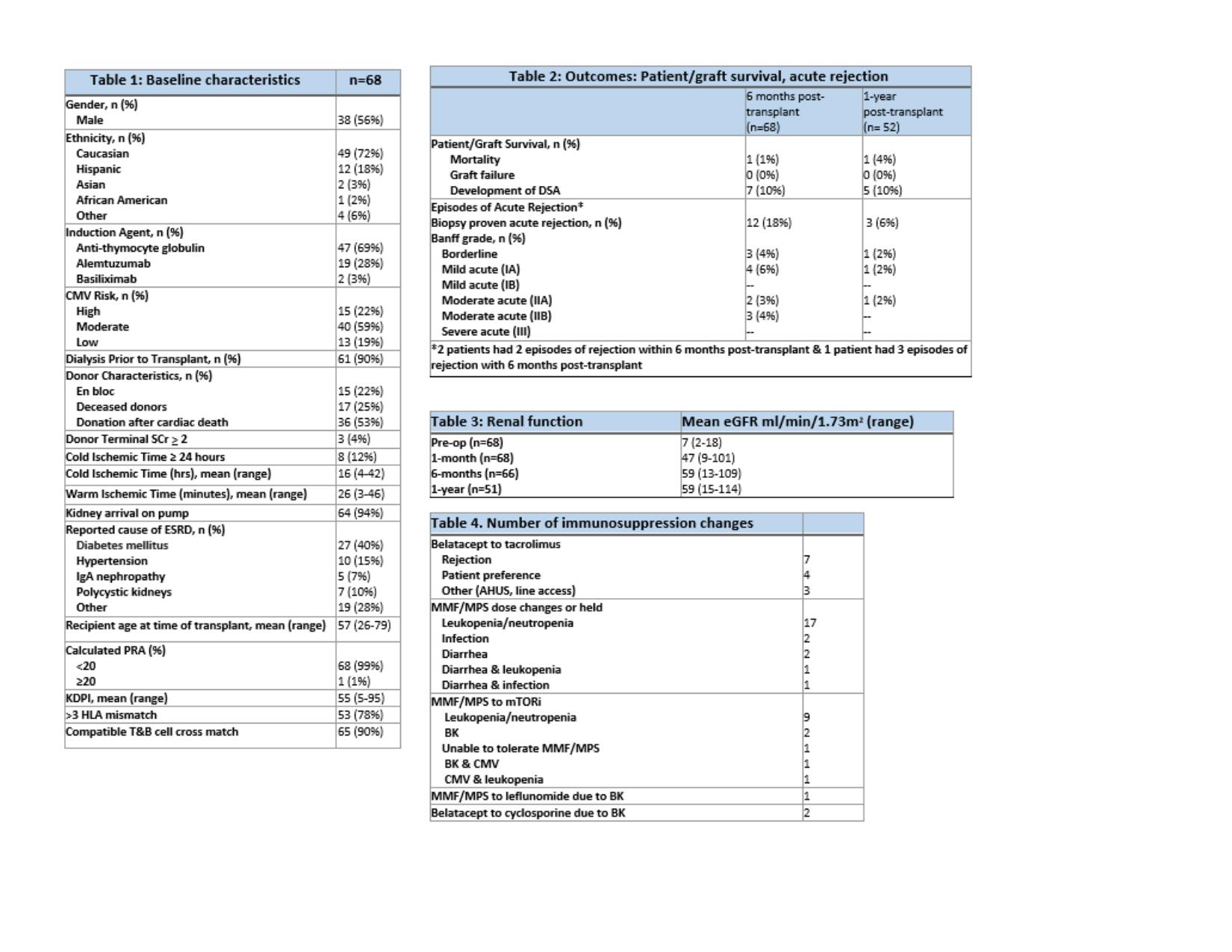Real World Experience Utilizing Donor Kidneys at Risk for Acute Kidney Injury with Belatacept Based Maintenance Immunosuppression
University of Utah Health, Salt Lake City, UT
Meeting: 2022 American Transplant Congress
Abstract number: 1690
Keywords: Co-stimulation, Donors, marginal, Immunosuppression, Kidney transplantation
Topic: Clinical Science » Kidney » 38 - Kidney Immunosuppression: Novel Regimens and Drug Minimization
Session Information
Session Name: Kidney Immunosuppression: Novel Regimens and Drug Minimization
Session Type: Poster Abstract
Date: Tuesday, June 7, 2022
Session Time: 7:00pm-8:00pm
 Presentation Time: 7:00pm-8:00pm
Presentation Time: 7:00pm-8:00pm
Location: Hynes Halls C & D
*Purpose: The demand for kidney transplant continues to rise, and limited supply has encouraged acceptance of marginal donor organs, such as those at risk for acute kidney injury (AKI). We evaluated the utilization of such organs (defined as donation after cardiac death, pediatric donors, kidneys with a cold ischemic time >24 hrs, terminal serum creatinine (SCr) >2mg/dL or rising SCr with decreasing urine output at donation) at our center who were discharged on belatacept based maintenance immunosuppression with mycophenolate and steroids (BBMS).
*Methods: This retrospective, descriptive study examined kidney transplant recipients (KTR) who received AKI organs and were discharged on BBMS between 1/2019-4/2021. Primary outcome assessed graft function and rejection at 6 & 12 months (mos) post-transplant (txp). Secondary outcomes evaluated graft failure, mortality, infection, DSA & changes to BBMS. All outcomes were evaluated at 1yr if records were available.
*Results: 68 KTR w/1 yr results & 52 w/6 mo results on BBMS were included. Baseline characteristics (Table 1) show most KTR received a DCD or en bloc organ and lymphocyte depleting induction. Mean eGFR improved from 1 to 6 mo post-txp and was stable through 1yr. Episodes of biopsy proven rejection were more common during the first 6mos post-txp. There were 2 deaths during the study period, due to COVID, and no graft failures. Twelve KTR developed DSA. There were 21 KTR with CMV viremia, mostly in moderate risk group, & 12 with BK viremia. Table 4 shows changes to BBMS occurred in 32 KTR. Most KTR required multiple BBMS changes with most common dose adjustments to mycophenolate due to leukopenia or neutropenia.
*Conclusions: Utilization of AKI organs with BBMS in KTR at our center resulted in no graft failures & sustained eGFR despite more rejection episodes during the first 6mos post-txp. Although 32 KTR had changes to BBMS, only 5 KTR had rejection following a change. Incidence of CMV was common but did not impact KTR outcomes. Overall, BBMS could be a promising option in AKI organs to avoid nephrotoxicity associated with CNI based regimens. These findings suggest the need to further evaluate the impact of long-term outcomes associated with changes made to BBMS in AKI donor organs.
To cite this abstract in AMA style:
Sirandas B, Chan A, Eiting M, Larson T, Truax C, Smith L. Real World Experience Utilizing Donor Kidneys at Risk for Acute Kidney Injury with Belatacept Based Maintenance Immunosuppression [abstract]. Am J Transplant. 2022; 22 (suppl 3). https://atcmeetingabstracts.com/abstract/real-world-experience-utilizing-donor-kidneys-at-risk-for-acute-kidney-injury-with-belatacept-based-maintenance-immunosuppression/. Accessed December 15, 2025.« Back to 2022 American Transplant Congress

